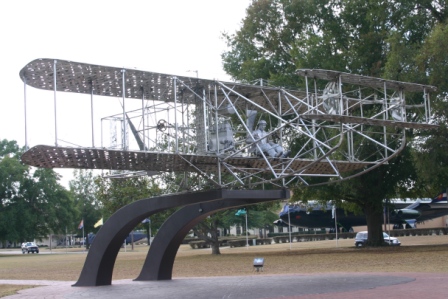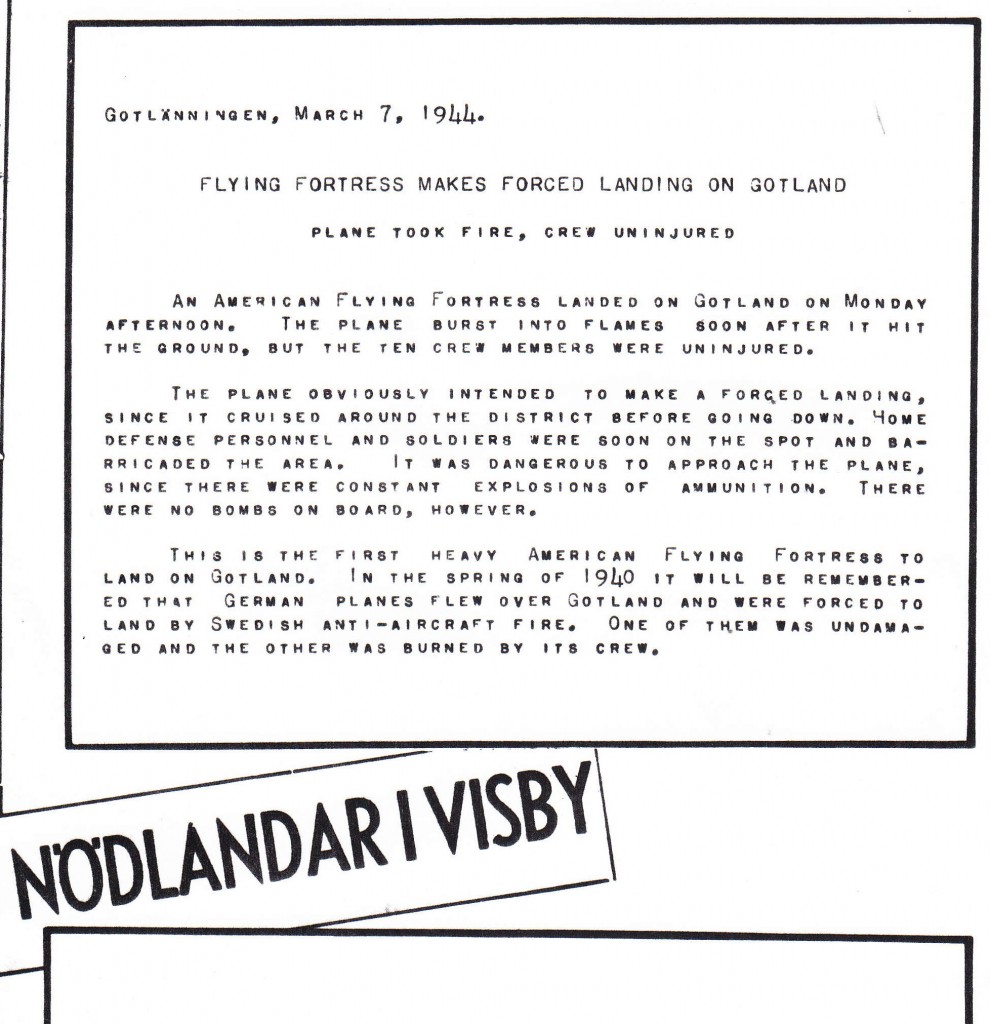22 Oct Air Force Historical Research Agency

Wright Flyer monument sculpted by Alabama’s Larry Godwin in 1985
This week I spent two days at Maxwell Air Force Base in Montgomery, Alabama. I owe a deep debt of gratitude to Colonel Gordon Pickler who “showed me the ropes.”
I asked Gordon, “Why is all of this located in Montgomery?” He explained that the Wright Brothers had a flying field here in 1910. During World War I the federal government leased this land and later bought it. It expanded and grew through the years. Today it is the site of Air University, established after World War II, a primary site for Air Force professional military education.
First of all, the campus is beautiful. The colonial style Senior Officer Quarters were built before World War II and sit elegantly on wooded lots. Historic and modern planes are on display in the Air Park, including the Wright Flyer monument.
Where I spent my time was at the Air Force Historical Research Agency. Before visiting Maxwell, be sure to follow carefully their directions on what is required in order to get on base. They mean it. And no talking on your cell phone while you drive around. The research building is shared with the Air University Library … huge with what must be one of the most complete collections anywhere of modern and historic military books.
Much like the National Archives, historical Air Force records are stored here, going back to the 2nd World War. You search through their catalogues (or on-line ahead of time ) and ask for boxes of (in my case) historic files to be brought to you. There is a copy machine right there (small fee.) I was able to set up my laptop and scanner and get right to work. The staff was extremely patient and helpful. For the most part I was the only researcher in the Reading Room.
Finding what you want is like looking for the golden egg at an Easter Egg Hunt. You look through file after file, searching for clues … for a name you recognize. For the dates you need.
I found the summary data on each day of Herman’s missions. I did not see individual pilot’s reports or logs. And surprisingly, there was little to be found on the Big Week missions. (The 8th Air Force Museum in Savannah helped me more with the 306th Bomber Squadron.)
As for the Swedish Internees, I did get new and helpful information. What I was looking for in particular were individual reports on each crew that force landed. Many were put on microfilm years ago, and in some cases the original documents were destroyed. I was unable to read the microfilm well enough to find what I was looking for.
Here is one of my “Golden Eggs” … This was published in Sweden the day after the Liberty Lady crashed on the island of Gotland. I would be very grateful if someone reading this could let me know the particulars. Perhaps it was in a newsletter circulated in the Internment Camps.
As always, I am searching for clues …

Update: Read about my 2nd visit to the Air Force Historical Research Agency.


William P. Maher Jr.
Posted at 21:11h, 22 OctoberWhat is the best source for “individual pilot’s reports or logs.”?
I have not (yet) been to the 8th Air Force Museum or the Research Agency.
Sounds like a great place to continue the search.
Best regards,
Patrick
Pat
Posted at 06:28h, 25 OctoberPatrick, that is a great question. There are many documents on microfilm but I wasn’t able to read them. Perhaps it was the machine. 8th Air Force Museum has a wealth of information on the 306th BS, collected by veterans who visitied the National Archives in DC. If you think you want to go to Savannah, call the Librarian first about what you’re looking for. She was extremely helpful to me. The website for the 303rd BS is amazing. THANKS, Pat
M Eneqvist
Posted at 16:52h, 10 NovemberThe note is from the local news paper on Gotland I have read this on swedich. maybe some one from American legation has translate it
LEMER GEORGES
Posted at 14:20h, 16 FebruaryBONJOUR à tous . Je ne parle pas l’anglais! j’ai paeticipé à l’edification de 4 stéles en hommage à des équipages de la 8 air force qui à borbde ” b 17 ” sont crashés dans notre région en 1943 . DEpuis bien longtemps je cherche l’identification d’un crash en 1943 malgrés des indices sur le terrain (aluminiun,plexi,munition …) pas possible de mettre un nom sur cet équipage.Lieu geographique (N 47.43 28 W 03.4 28 ) LOCOAL-MENDON ( LAPAUL ) FRANCE . Peu de renseignement de la population . IL y eu au moins 3 rescapés qui prirent la fuite en passant sous la voie de chemin de fer laissant leur veste sur l’aile gauche car l’avion s’écrasé aprés avoir heurté un pylone électrique et des arbres il n’a pas pris feu . remerciements sincéres . georges.
Pat DiGeorge
Posted at 17:24h, 20 FebruaryGeorges, I am going to write a rough translation of your comment. If anyone can add/edit to this I would be very grateful. I posted this on my armyairforces.com forum in hopes that someone there might recognize the incident. If I get an answer I will certainly let you know.
“I don’t speak English! I participated in the construction of 4 pillars in homage to some crews of the 8th Air Force that (surrounded ? bordered ?) a B 17 crashed in our region in 1943.
For quite a while now I have not been able to put a name to this crew.
Geographic location (N 47.43 28 W 03.4 28 ) LOCOAL-MENDON ( LAPAUL ) France. Little information from the population.
There were at least three survivors that took flight while passing under the line of fire leaving their jacket on the left wing because the plane crashed after having collided with an electric pylon and some trees. It didn’t catch fire.
Sincerest thanks, Georges
Dave Gansz
Posted at 14:48h, 04 SeptemberSaw you note on the Army Air Forces web site for Lemers Georges, posted the following responce – hope it helps:
Only aircraft that seems to fit is:
42-5219 MIA 17 May 1943 (305th BG / 364th BS — [WF*K]).
(Pilot: 2Lt Roy E Richards) – 6 KIA, 4 POW (MACR 15569).
Crashed near Auray, Brittany (47°39’53″N 2°58’29″W)
Shot down by Fw. Wilhelm Kopp 9./JG 2 (4843 / 14 West (47°42’48″N 3°6’22″W) 7.000 m. @ 12.20)
Pat DiGeorge
Posted at 07:49h, 20 SeptemberThank you Dave. I have contacted Georges. I hope he will get in touch with you. THANKS, Pat